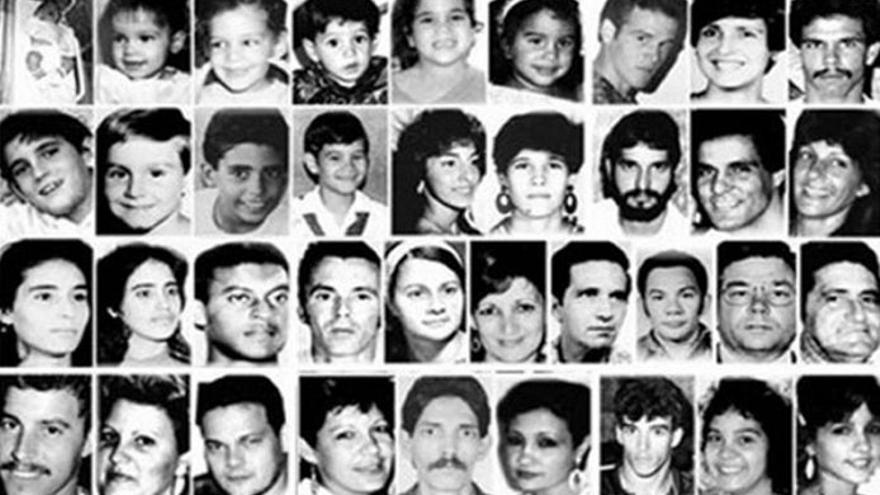
![]() 14ymedio, Yoani Sánchez, Havana, 13 July 2019 — From that year I remember the wait, it was a feeling that filled everything like the unstoppable ticking of a story that was about to end. More than hunger, the heat of summer and the blackouts, the most difficult thing to endure was that prolonged parenthesis that had become our lives. And then July and August of 1994 arrived. The months in which we lost the little innocence we had left.
14ymedio, Yoani Sánchez, Havana, 13 July 2019 — From that year I remember the wait, it was a feeling that filled everything like the unstoppable ticking of a story that was about to end. More than hunger, the heat of summer and the blackouts, the most difficult thing to endure was that prolonged parenthesis that had become our lives. And then July and August of 1994 arrived. The months in which we lost the little innocence we had left.
The news was diffuse, fragmented. “It was there, at the exit of the bay,” pointed out some residents in my Havana neighborhood of San Leopoldo, in the days after that 13 July when 37 people lost their lives at sea, among them 10 children. At first it seemed unreal, one more rumor of a frustrated escape, but little by little the story began to take shape, we knew the names of the victims and we knew the details of their last minutes.
Three tugboats — Polagaro 2, Polagaro 3 and Polagaro 5 — had sunk a ship carrying 72 people who were traveling with their eyes focused on the other side of the Florida Straits. People escaping a deep, dehumanizing crisis, which the ruling party had baptized with the “nice” euphemism of “Special Period in Times of Peace.” But in fact it was a time of material and moral deterioration, when children went to their parents with their hands out to ask for a piece of bread, a time when from the rostrum a delirious Fidel Castro called on us to “resist and win.”
That morning, 25 years ago, a few kilometers from the bed where I slept my apathetic dreams of adolescence, a terrifying scene developed that has been reconstructed thanks to the testimony of the survivors. The three tugs that were chasing the migrants pointed high pressure water hoses on them, knocking several adults and children off the deck. Those traveling on 13 de Marzo tugboat could do little against the onslaught.
The sea was filled with tumult and shouting a few meters from the imperturbable lighthouse of Morro, the same one that weeks later would again see avalanches of people leaving, this time in fragile crafts. While the water filled the throats of those dozens of people, others sitting along the wall of the Malecón to alleviate the summer heat stared out to sea imagining their dreams of a future in another place.
Then, the official media recrafted the story at will and blamed the tragedy on those who had stolen the 13 de Marzo tugboat and accused them of being irresponsible. They said that “the accident” was due to a collision between the fleeing ship and one of the Polargo tugboats, a version widely refuted by eyewitnesses who spoke of persecution, purposeful ramming of the boat, and water hoses. The state newspaper Granma also blamed the sinking on strong swells, low visibility and the deteriorated state of the boat itself.
The Communist Party militants were ‘oriented’ to tackle the rumors of state responsibility in the action, the Rapid Response Brigades greased their parapolice mechanisms of repression and a slab of silence was placed over that 13 July, similar to that the Chinese authorities have put on the events of Tiananmen Square. Even today, a quarter of a century later, the majority of Cubans living on the island avoid talking about it in public.
In their study circles, the militants of the Cuban Communist Party (PCC) denounced the “new hoax of the empire,” while some calculated how to get rid of the red card they carried in their pockets and emigrate to that place where “the enemy” lived. Most of the bodies of the victims were never recovered from the bottom of the waters and, to this day, Havana is missing a monument that remembers them. Despite its seriousness, the event is not studied in any History class in the schools of the Island.
During the days following that morning, the official media did not lose any opportunity to paint the actions of the Polargos as part of the revolutionary militancy that had motivated the crew of the three ships to try to prevent the theft of the tugboat. They exempted the authorities from any responsibility, not one of the perpetrators of the sinking was prosecuted and, instead, their work received copious praise from the Plaza of the Revolution.
With such complicity and without an institutional investigation, the tragedy became a state crime. Especially because it was used to induce fear in a civilian population about what could happen to them if they tried to escape from the “socialist paradise” imprisoning us. But even terror did not work.
Less than four weeks later the Maleconazo erupted and finally Castro opened the national borders for anyone who wanted to emigrate. Thousands and thousands. This time the Polargos did not go out to chase them, but many also drowned. The dramatic events of that summer put an end to the last illusions of a subjugated people.
___________________
The 14ymedio team is committed to serious journalism that reflects the reality of deep Cuba. Thank you for joining us on this long road. We invite you to continue supporting us, but this time by becoming a member of 14ymedio. Together we can continue to transform journalism in Cuba.
